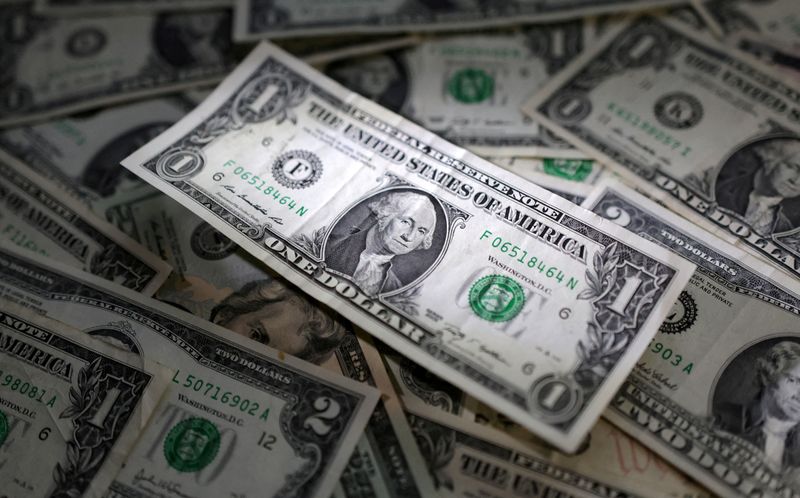A look at the day ahead in U.S. and global markets from Mike Dolan
Helped by a backup in U.S. Treasury yields, the dollar has rediscovered its mojo ahead of a wave of overseas interest rate cuts this week, with China’s markets giving only a hesitant welcome to Beijing’s new policy orientation.
As Treasury debt sales resume in earnest later on Tuesday and Wednesday’s consumer price inflation report is awaited, 10-year yields have nudged back above 4.2%.
That follows a three-week swoon of more than 30 basis points from post-election highs and a puncturing of bond volatility gauges to their lowest in more than two years.
The foothold for yields helped lift the dollar too, especially against currencies facing another round of central bank easing this week.
The greenback hit its highest against the Canadian dollar since April 2020, as traders mull whether the Bank of Canada will cut its main interest rate by another 50bps on Wednesday – not least as U.S. President-elect Donald Trump’s tariff threats hit sentiment there.
But with the European Central Bank and Swiss National Bank also expected to cut rates again this week, the euro and Swiss franc were also back under pressure.
Even though the Reserve Bank of Australia held the line overnight, there were enough dovish noises there to drag the Aussie dollar lower too.
In China, the full market reaction to Monday’s historic Politburo shift in monetary and fiscal direction was a bit underwhelming – in part because the latest sweep of economic reports show just how badly more stimulus is needed.
China’s exports slowed sharply and imports unexpectedly shrank in November, another worrying sign for the world’s No. 2 economy as Trump’s imminent return to the White House brings fresh trade risks.
While markets had recently been encouraged by surveys showing manufacturing sentiment at its best in seven months, they also warned they were receiving fewer export orders.
And all that follows fresh price data this week showing the country still dallying with deflation more broadly.
Monday’s late announcement on the new policy tack had lifted Hong Kong stocks by more than 2% but they gave back about 0.5% of that today. Mainland indexes were closed by the time Monday’s reports hit but gained less than 1% today.
Ten-year Chinese government bond yields plumbed new record lows below 1.9%, but the offshore yuan held steady.
More broadly, the worrying Chinese trade numbers dragged oil prices back down and basic resources stocks led European indexes lower too.
Continued political tensions in South Korea, meantime, saw the won fall again even though the KOSPI stock benchmark bounced back about 2%.
South Korea’s opposition-controlled parliament on Tuesday passed a government budget bill for 2025 that was slashed from the government’s proposal and triggered President Yoon Suk Yeol’s short-lived martial law decree last week.
The Indian rupee slipped to a record low and government bond yields fell on Tuesday, as the appointment of career bureaucrat Sanjay Malhotra as the next governor of the Reserve Bank of India (NS:BOI) prompted traders to up bets on rate cuts.
In Brazil, there may be some anxiety over the health of President Luiz Inacio Lula da Silva, who underwent surgery overnight in Sao Paulo to drain a bleed on his brain linked to a fall at home in October. The surgery was successful and the 79-year-old Lula is “well” and being monitored in the intensive care unit, doctors said.
Back on Wall Street, the CPI vigil and a 3-year Treasury note sale are accompanied by the latest NFIB small business survey that should give a glimpse of post-election sentiment.
Fed futures still price about a 90% chance of another rate cut next week, while stock futures held steady despite Monday’s modest pullback from new records.
The S&P500 slip was led by Nvidia (NASDAQ:NVDA) after China said on Monday it had launched an investigation into the U.S. chip giant over suspected violations of the country’s anti-monopoly law – a probe widely seen as a retaliatory shot against Washington’s latest curbs on the Chinese chip sector.
Key developments that should provide more direction to U.S. markets later on Tuesday:
* U.S. November NFIB small business survey, Q3 unit labor costs and productivity revisions
* US corporate earnings: Autozone

* European Union finance ministers meet in Brussels on draft budget plans, with European Central Bank Vice President Luis de Guindos
* U.S. Treasury sells $58 billion of 3-year notes



